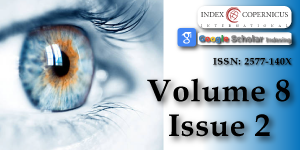Comparative Analysis of Demographic and Clinical Profiles of Conventional Retinopathy of Prematurity with Aggressive Posterior Retinopathy of Prematurity
Main Article Content
Article Details
Copyright (c) 2024 Lochab S, et al.

This work is licensed under a Creative Commons Attribution 4.0 International License.
Bashinsky AL. Retinopathy of prematurity. N C Med J. 2017;78(2):124-128. Available from: https://doi.org/10.18043/ncm.78.2.124
Hellström A, Smith LE, Dammann O. Retinopathy of prematurity. Lancet. 2013;382(9902):1445-1457. Available from: https://doi.org/10.1016/s0140-6736(13)60178-6
Campbell K. Intensive oxygen therapy as a possible cause of retrolental fibroplasia: a clinical approach. Med J Aust. 1951;2(2):48-50. Available from: https://pubmed.ncbi.nlm.nih.gov/14874698/
Seiberth V, Linderkamp O. Risk factors in retinopathy of prematurity. Ophthalmologica. 2000;214(2):131-135. Available from: https://doi.org/10.1159/000027482
Purohit DM, Ellison RC, Zierler S, Miettinen OS, Nadas AS. Risk factors for retrolental fibroplasia: experience with 3,025 premature infants. Pediatrics. 1985;76(3):339-344. Available from: https://pubmed.ncbi.nlm.nih.gov/2863804/
Gilbert C. Retinopathy of prematurity: a global perspective of the epidemics, population of babies at risk and implications for control. Early Hum Dev. 2008;84(2):77-82. Available from: https://doi.org/10.1016/j.earlhumdev.2007.11.009
Holmström G, Thomassen P, Broberger U. Maternal risk factors for retinopathy of prematurity–a population‐based study. Acta Obstet Gynecol Scand. 1996;75(7):628-635. Available from: https://doi.org/10.3109/00016349609054687
Hammer ME, Mullen PW, Ferguson JG, Pai S, Cosby C, Jackson KL. Logistic analysis of risk factors in acute retinopathy of prematurity. Am J Ophthalmol. 1986;102(1):1-6. Available from: https://doi.org/10.1016/0002-9394(86)90200-x
Hartnett ME, Penn JS. Mechanisms and management of retinopathy of prematurity. N Engl J Med. 2012;367(26):2515-2526. Available from: https://doi.org/10.1056/nejmra1208129
International Committee for the Classification of Retinopathy of Prematurity. The international classification of retinopathy of prematurity revisited. Arch Ophthalmol. 2005 Jul;123(7):991-999. Available from: https://doi.org/10.1001/archopht.123.7.991
Chiang MF, Quinn GE, Fielder AR, Ostmo SR, Chan RP, Berrocal A, et al. International classification of retinopathy of prematurity. Ophthalmology. 2021;128(10):e51-68. Available from: https://doi.org/10.1016/j.ophtha.2021.05.031
Sanghi G, Sawhney JS, Kaur S, Kumar N. Evaluation of clinical profile and screening guidelines of retinopathy of prematurity in an urban level III neonatal intensive care unit. Indian J Ophthalmol. 2022;70(7):2476-2479. Available from: https://doi.org/10.4103/ijo.ijo_1925_21
Rashtriya Bal Swasthya Karyakram, Ministry of Health &Family Welfare, Government of India Guidelines for Universal Eye Screening in Newborns including Retinopathy of Prematurity June 2017 available at Available from: https://www.nhm.gov.in/images/pdf/programmes/RBSK/Resource_Documents/Revised_ROP_Guidelines-Web_Optimized.pdf
Vinekar A, Jayadev C, Mangalesh S, Shetty B, Vidyasagar D. Role of Tele-Medicine in retinopathy of prematurity screening in rural Outreach Centers in India – a report of 20,214 imaging sessions in the KIDROP program. Seminars in Fetal and Neonatal Medicine. 2015;20(5):335-345. Available from: https://doi.org/10.1016/j.siny.2015.05.002
Sathar A, Shanavas A, Jasmin LB, Girija Devi PS. Outcome of Aggressive Posterior Retinopathy of Prematurity in a Tertiary Care Hospital in South India. J Med Sci Clin Res. 2017;5(4):20885-20891. Available from: https://dx.doi.org/10.18535/jmscr/v5i4.182
Ahn YJ, Hong KE, Yum HR, Lee JH, Kim KS, Youn YA, et al. Characteristic clinical features associated with aggressive posterior retinopathy of prematurity. Eye (Lond). 2017 Jun;31(6):924-930. Available from: https://doi.org/10.1038/eye.2017.18
Bastola P, Parchand SM, Gangwe AB, Bastola S, Agrawal D. Retinopathy of Prematurity among Preterm Newborn Admitted to the Neonatal Care Unit in a Tertiary Care Centre: A Descriptive Cross-sectional Study. JNMA J Nepal Med Assoc. 2023;61(260):329-333. Available from: https://doi.org/10.31729/jnma.8117
Dwivedi A, Dwivedi D, Lakhtakia S, Chalisgaonkar C, Jain S. Prevalence, risk factors and pattern of severe retinopathy of prematurity in eastern Madhya Pradesh. Indian J Ophthalmol. 2019;67(6):819-823. Available from: https://doi.org/10.4103/ijo.ijo_1789_18
Tekchandani U, Katoch D, Dogra MR. Five-year demographic profile of retinopathy of prematurity at a tertiary care institute in North India. Indian J Ophthalmol. 2021;69(8):2127-2131. Available from: https://doi.org/10.4103/ijo.ijo_132_21
Shah VA, Yeo CL, Ling YL, Ho LY. Incidence, risk factors of retinopathy of prematurity among very low birth weight infants in Singapore. Ann Acad Med Singap. 2005;34(2):169-178. Available from: https://pubmed.ncbi.nlm.nih.gov/15827664/
Thomas K, Shah PS, Canning R, Harrison A, Lee SK, Dow KE. Retinopathy of prematurity: risk factors and variability in Canadian neonatal intensive care units. J Neonatal Perinatal Med. 2015;8(3):207-214. Available from: https://doi.org/10.3233/npm-15814128
Hakeem AH, Mohamed GB, Othman MF. Retinopathy of prematurity: a study of prevalence and risk factors. Middle East Afr J Ophthalmol. 2012 Jul;19(3):289-294. Available from: https://doi.org/10.4103/0974-9233.97927
Nayyar M, Sood M, Panwar PK. Profile and risk factors of sight-threatening retinopathy of prematurity: Experience from SNCU in North India. Oman J Ophthalmol. 2024;17(2):224-233. Available from: https://doi.org/10.4103/ojo.ojo_167_23
Retinopathy of prematurity: a review of risk factors and their clinical significance. Kim SJ, Port AD, Swan R, Campbell JP, Chan RV, Chiang MF. Surv Ophthalmol. 2018;63:618-637. Available from: https://doi.org/10.1016/j.survophthal.2018.04.002
Dhull V, Phogat J, Agrawal A, Singh S, Gathwala G, Nada M, et al. Retinopathy of Prematurity: Analysis of Demographic and Clinical Profiles, Incidence, Risk Factors and Treatment Outcome. Saudi J Med Pharm Sci. 2019;5(7):626-636. Available from: https://saudijournals.com/media/articles/SJMPS_57_626-636_c.pdf

